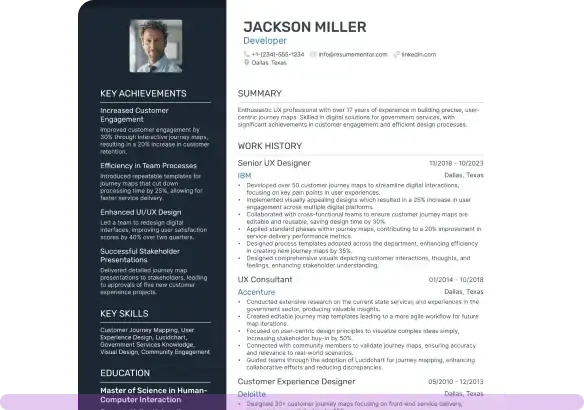Interior Design Resume Examples

Mar 25, 2025
|
12 min read
Craft your perfect interior design resume that stands out in style and creativity. Showcase your skills, experience, and passion, and watch your career flourish. Make your resume the blueprint for your future success.
Rated by 348 people
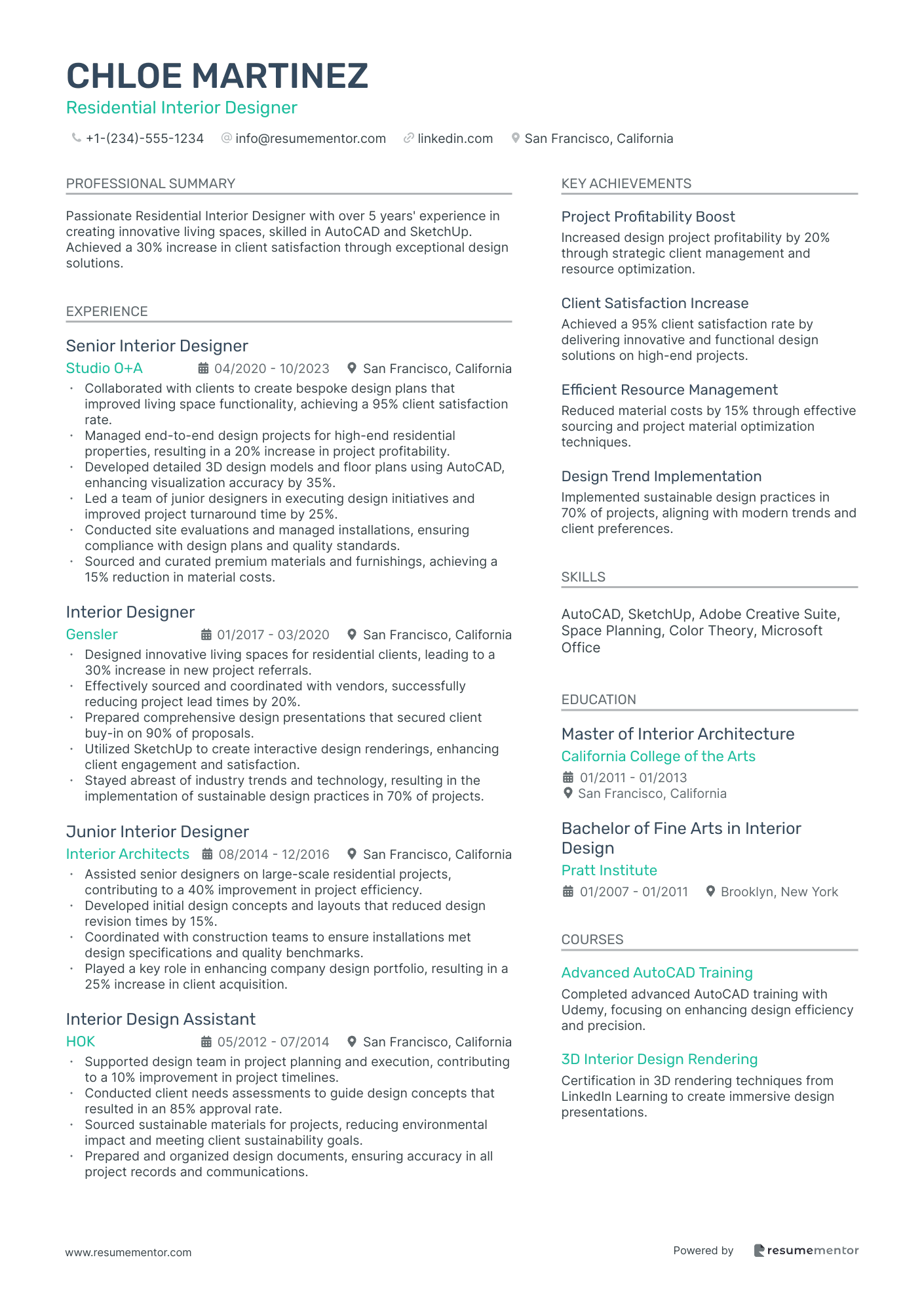
Residential Interior Designer
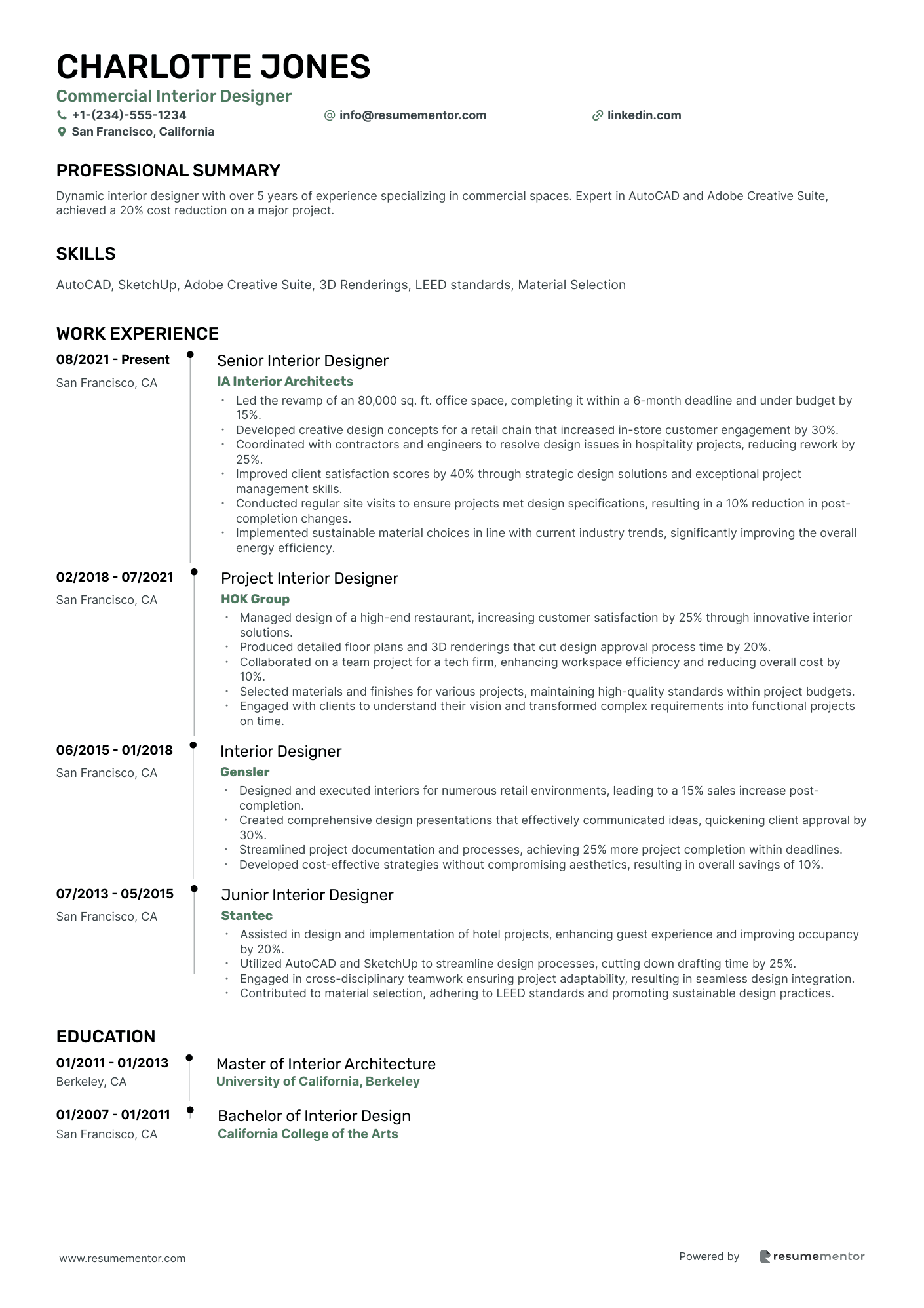
Commercial Interior Designer
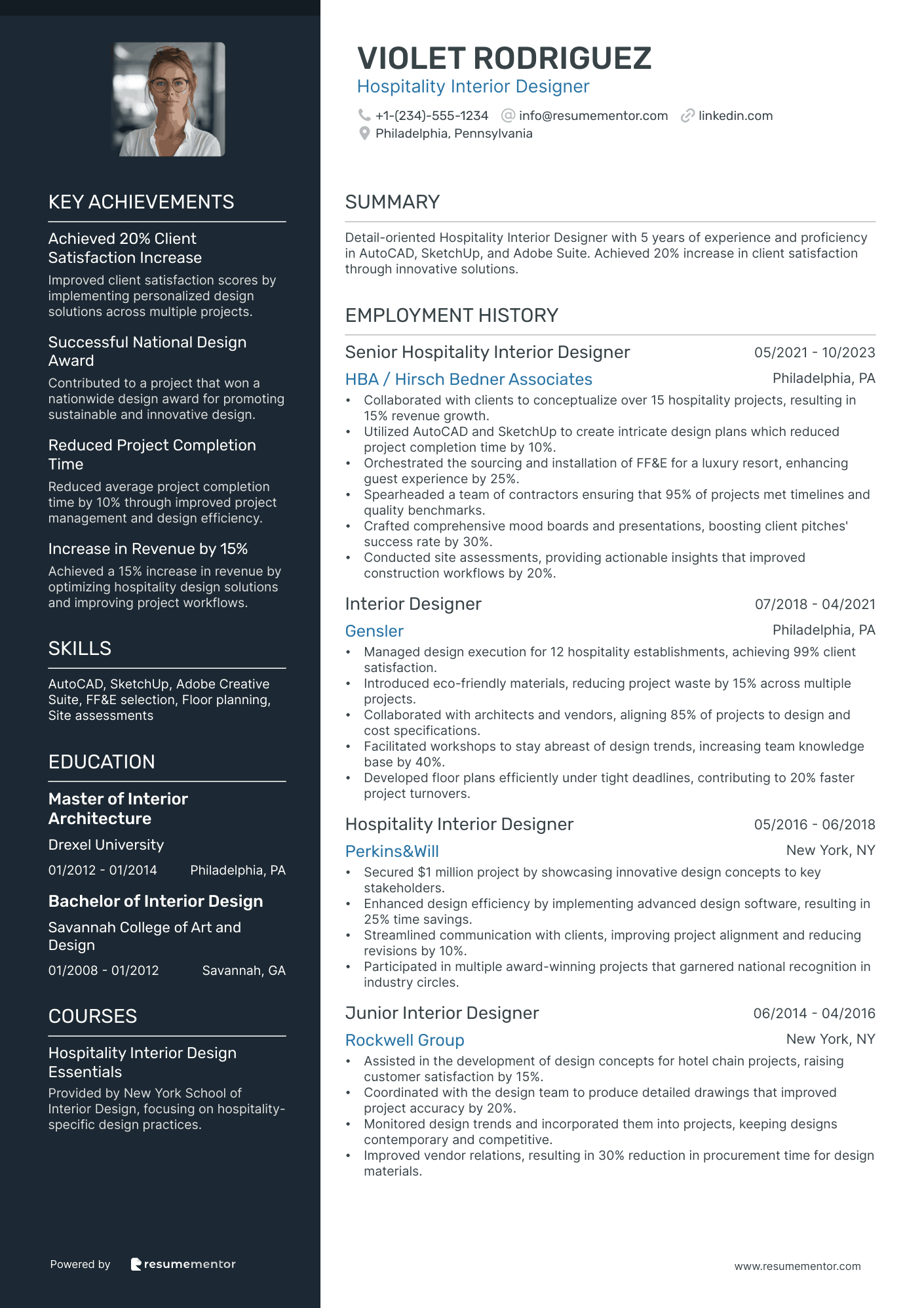
Hospitality Interior Designer
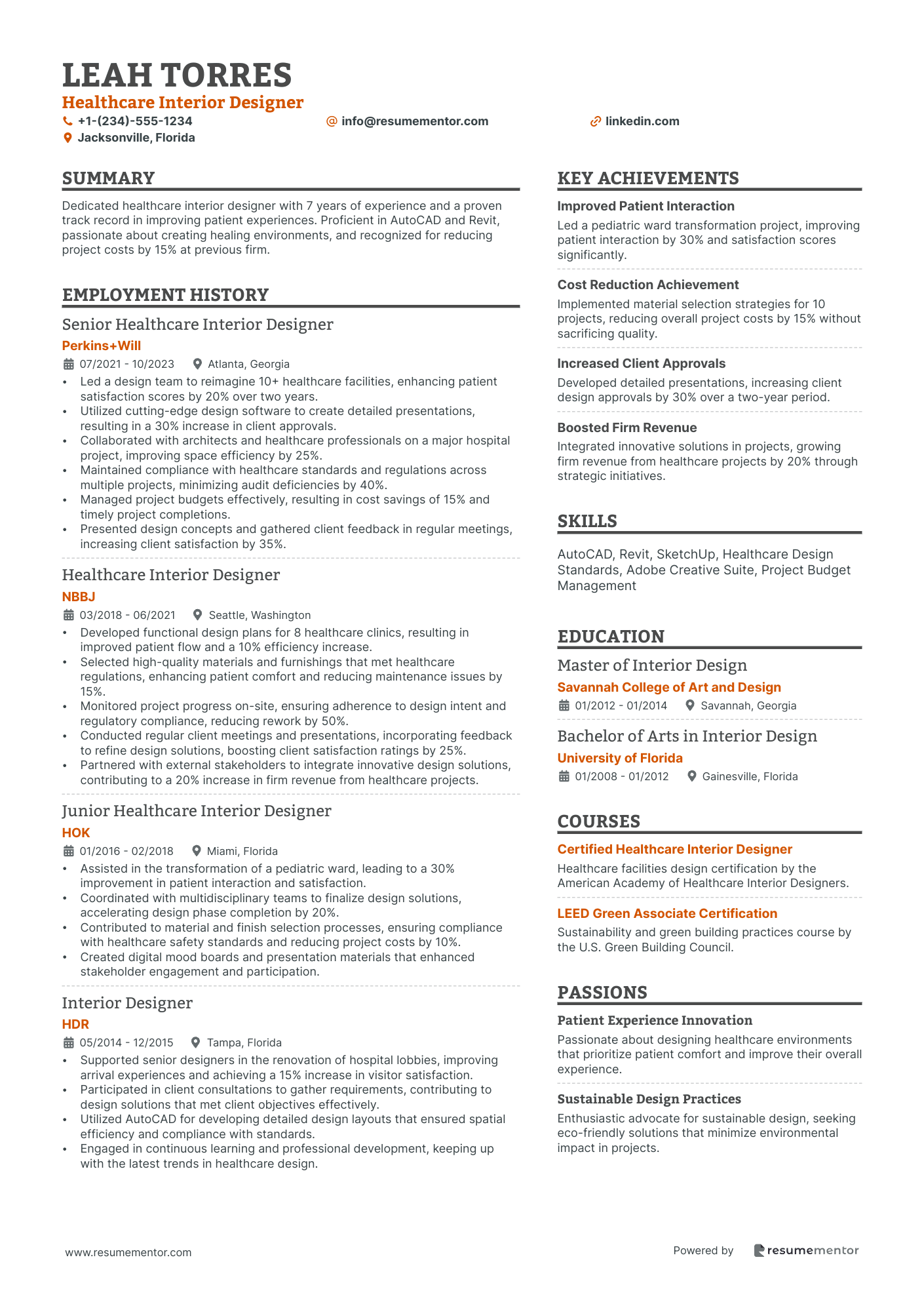
Healthcare Interior Designer
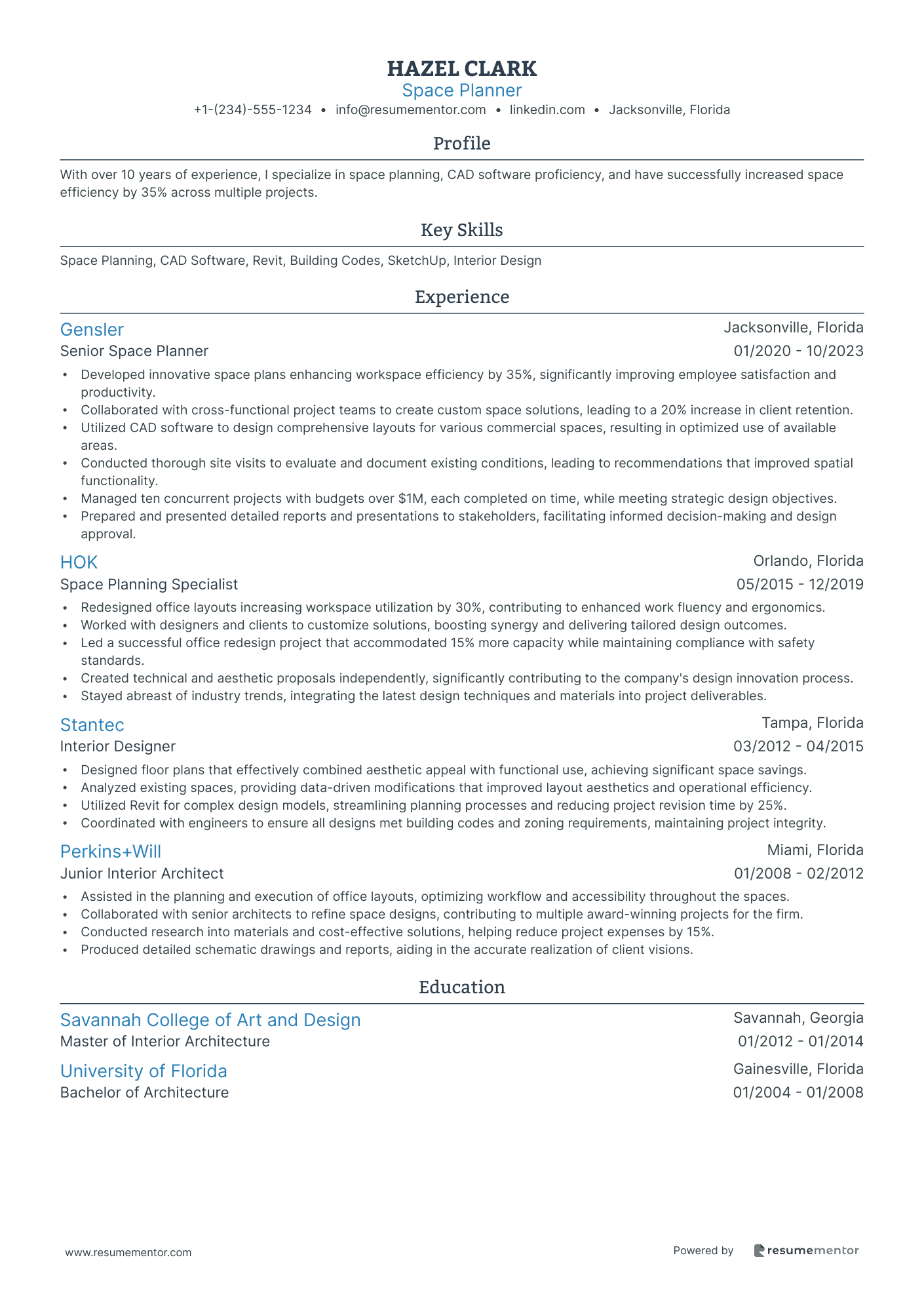
Space Planner
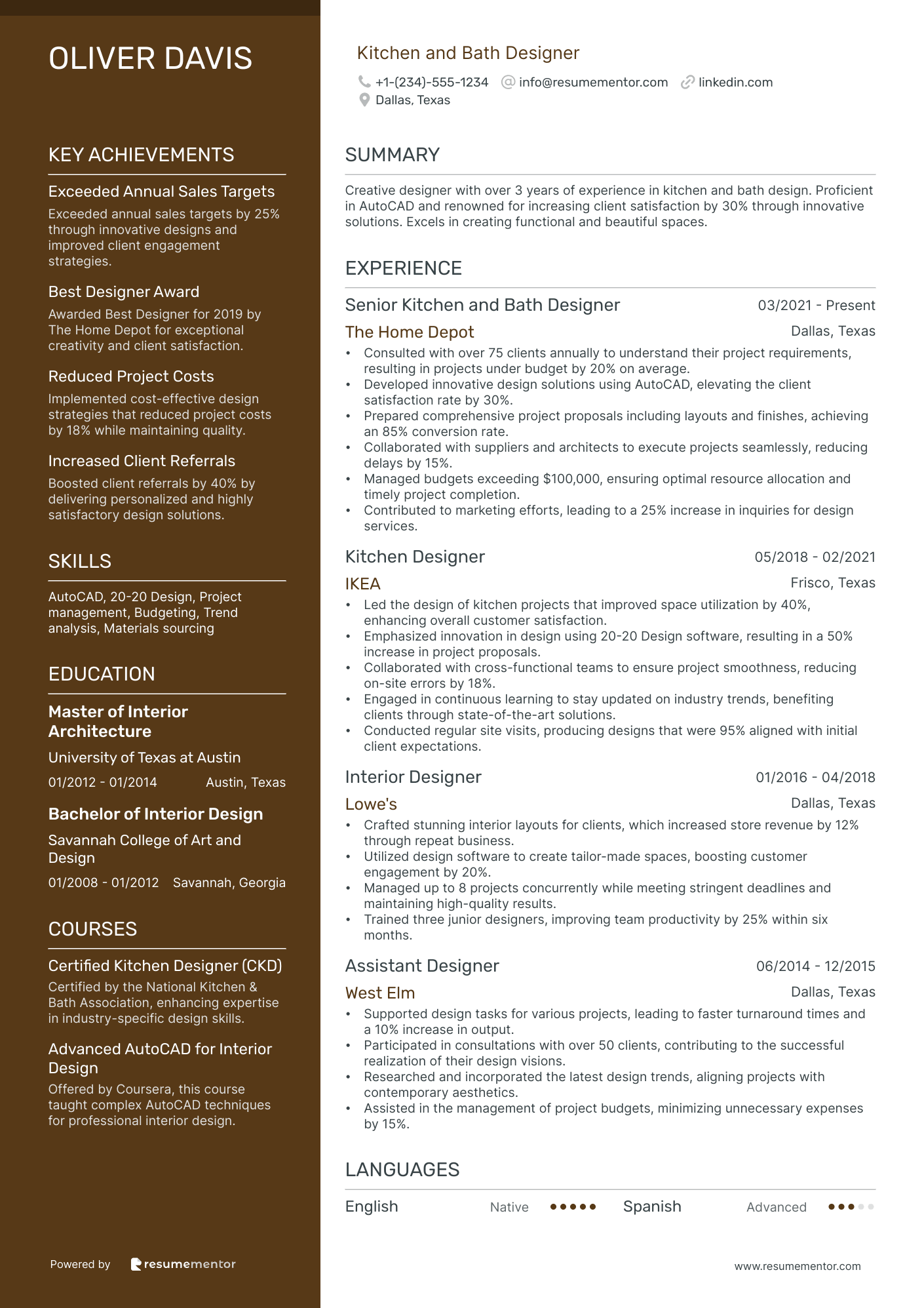
Kitchen and Bath Designer
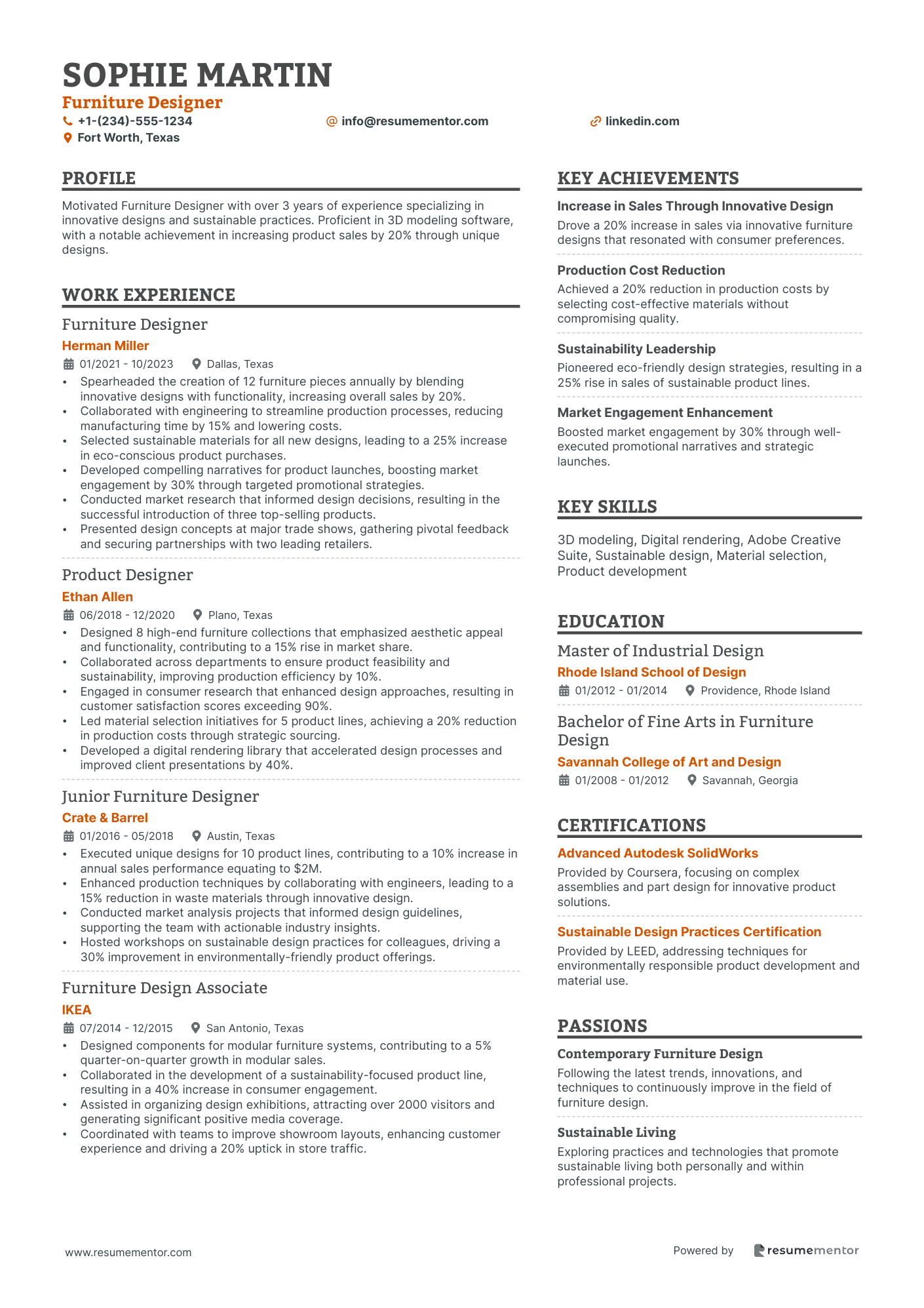
Furniture Designer
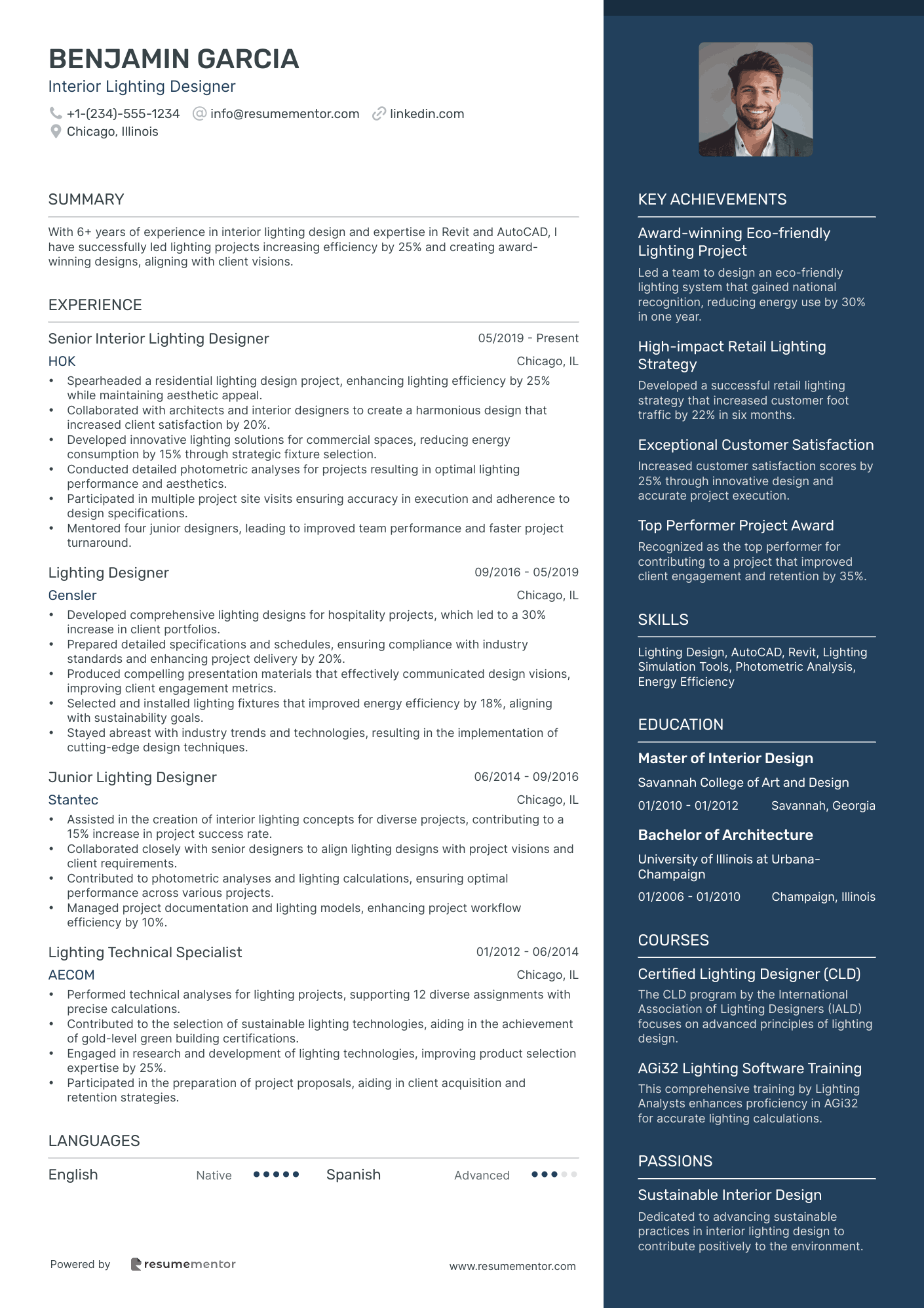
Interior Lighting Designer
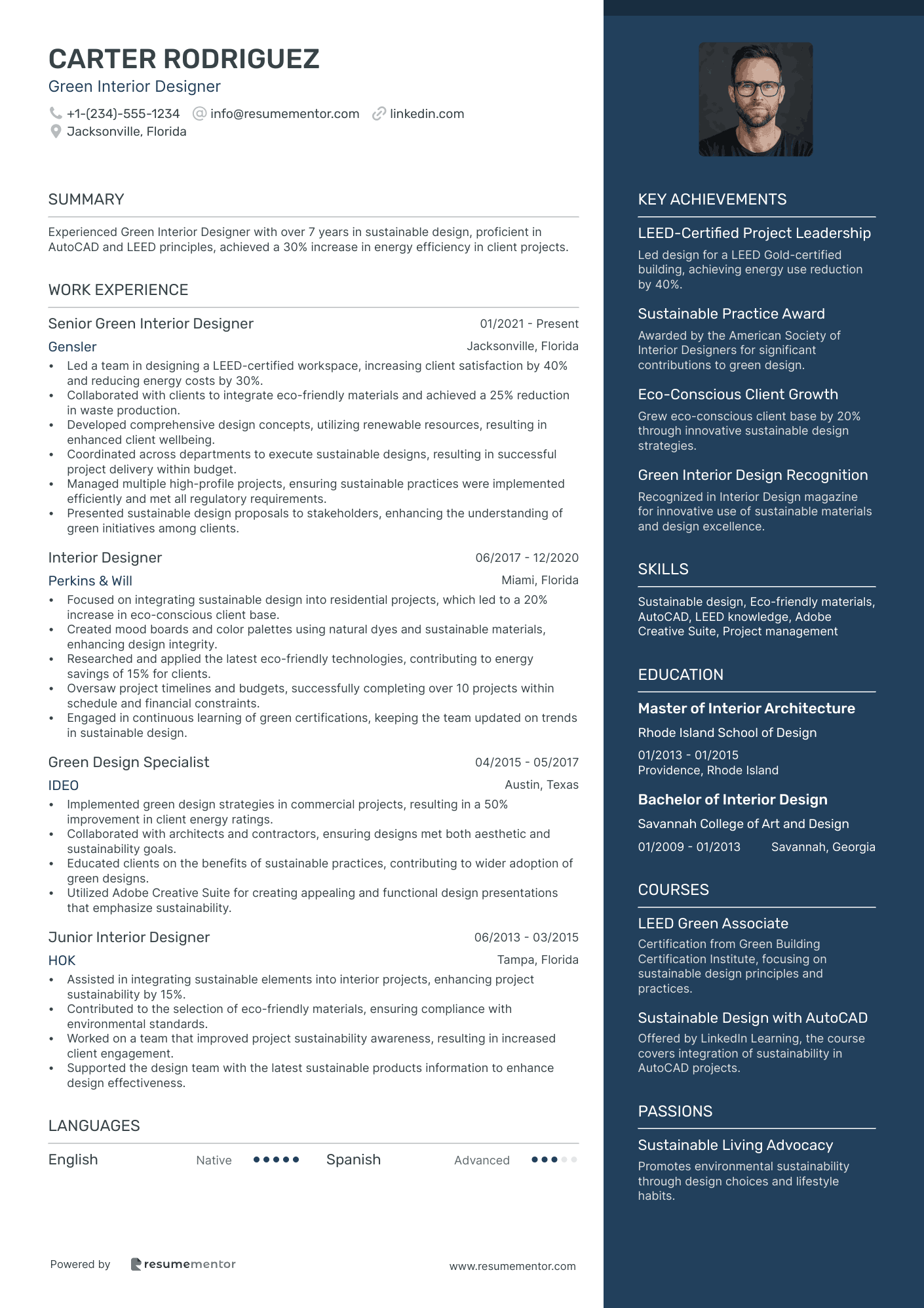
Green Interior Designer
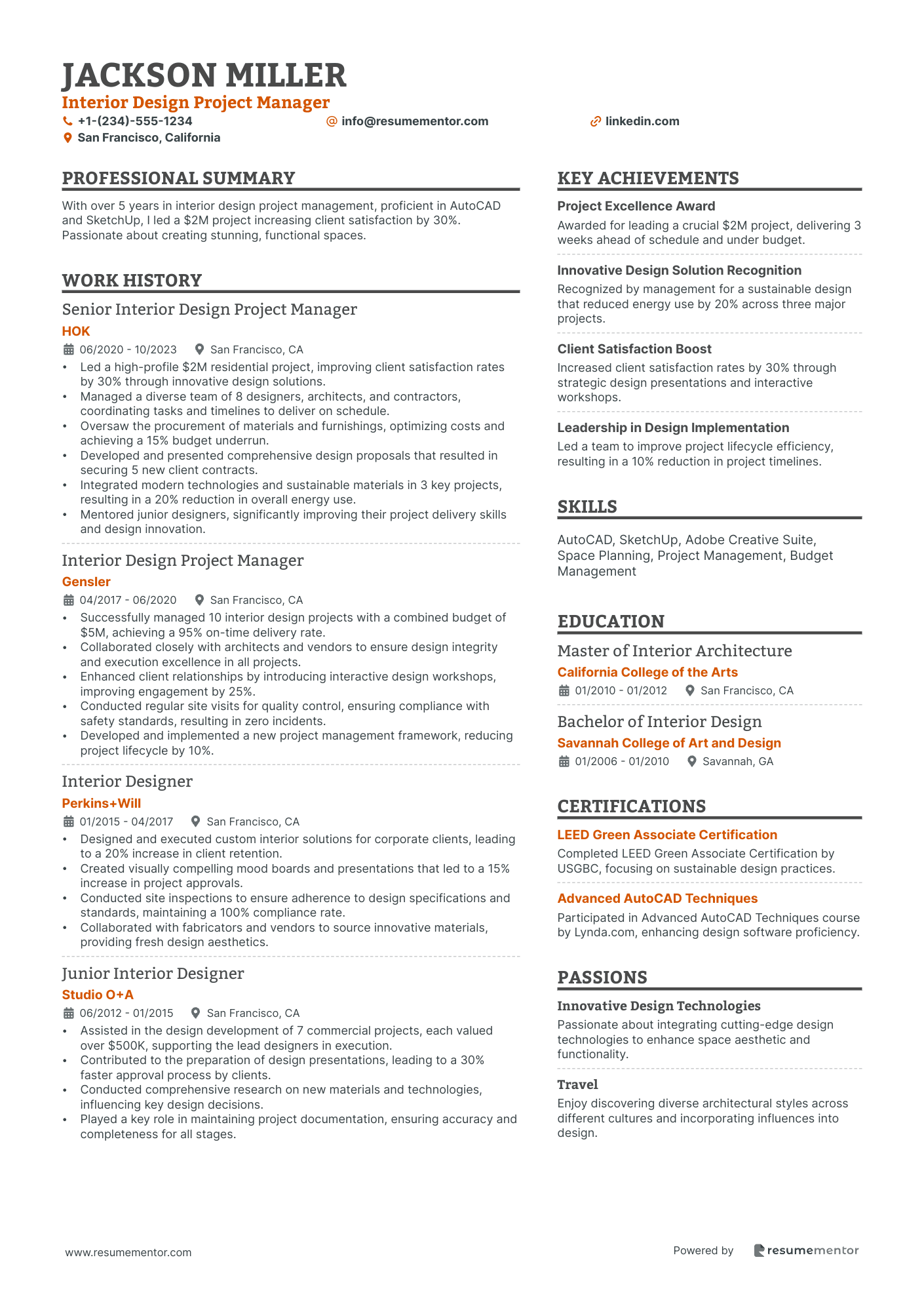
Interior Design Project Manager
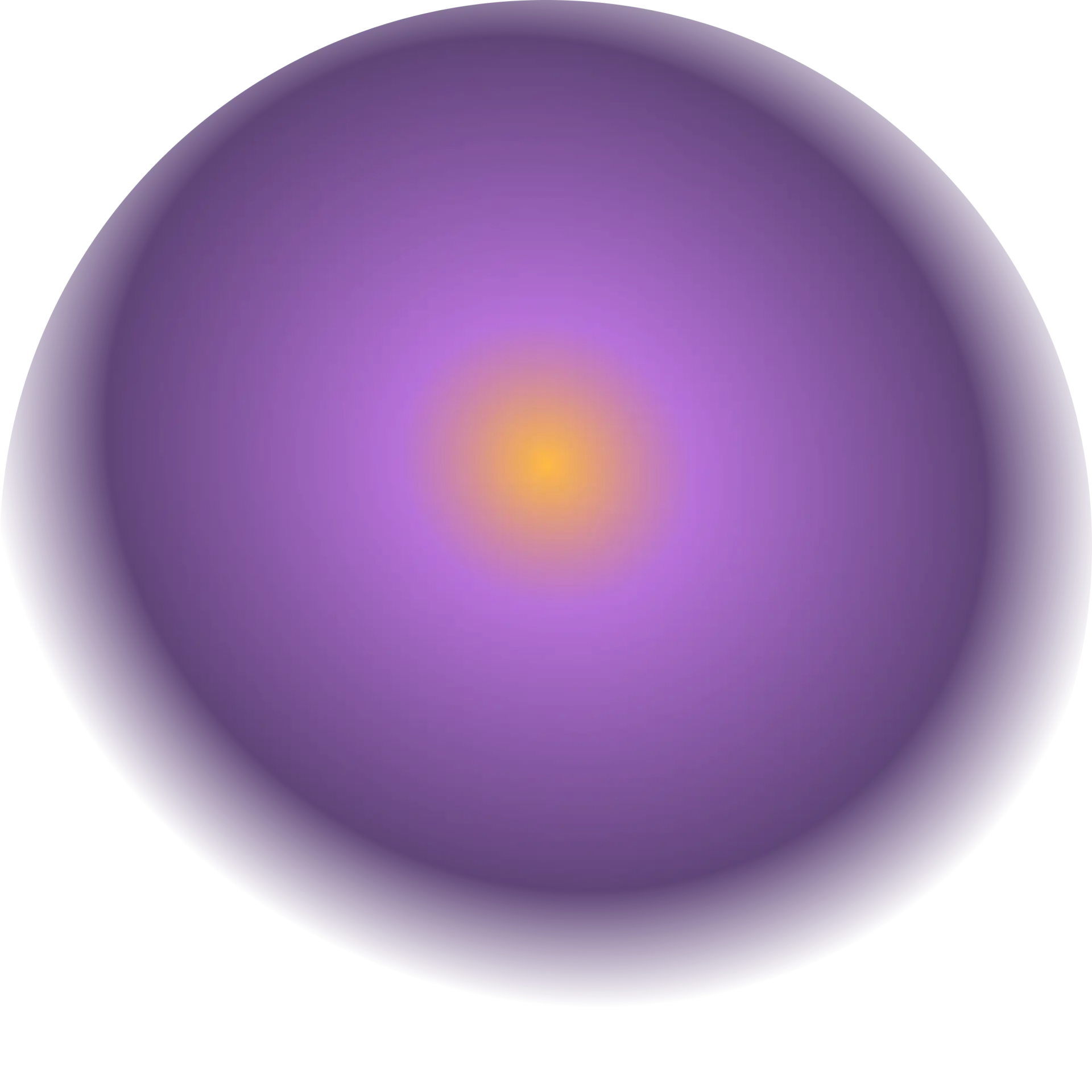
Residential Interior Designer resume sample
- •Collaborated with clients to create bespoke design plans that improved living space functionality, achieving a 95% client satisfaction rate.
- •Managed end-to-end design projects for high-end residential properties, resulting in a 20% increase in project profitability.
- •Developed detailed 3D design models and floor plans using AutoCAD, enhancing visualization accuracy by 35%.
- •Led a team of junior designers in executing design initiatives and improved project turnaround time by 25%.
- •Conducted site evaluations and managed installations, ensuring compliance with design plans and quality standards.
- •Sourced and curated premium materials and furnishings, achieving a 15% reduction in material costs.
- •Designed innovative living spaces for residential clients, leading to a 30% increase in new project referrals.
- •Effectively sourced and coordinated with vendors, successfully reducing project lead times by 20%.
- •Prepared comprehensive design presentations that secured client buy-in on 90% of proposals.
- •Utilized SketchUp to create interactive design renderings, enhancing client engagement and satisfaction.
- •Stayed abreast of industry trends and technology, resulting in the implementation of sustainable design practices in 70% of projects.
- •Assisted senior designers on large-scale residential projects, contributing to a 40% improvement in project efficiency.
- •Developed initial design concepts and layouts that reduced design revision times by 15%.
- •Coordinated with construction teams to ensure installations met design specifications and quality benchmarks.
- •Played a key role in enhancing company design portfolio, resulting in a 25% increase in client acquisition.
- •Supported design team in project planning and execution, contributing to a 10% improvement in project timelines.
- •Conducted client needs assessments to guide design concepts that resulted in an 85% approval rate.
- •Sourced sustainable materials for projects, reducing environmental impact and meeting client sustainability goals.
- •Prepared and organized design documents, ensuring accuracy in all project records and communications.
Commercial Interior Designer resume sample
- •Led the revamp of an 80,000 sq. ft. office space, completing it within a 6-month deadline and under budget by 15%.
- •Developed creative design concepts for a retail chain that increased in-store customer engagement by 30%.
- •Coordinated with contractors and engineers to resolve design issues in hospitality projects, reducing rework by 25%.
- •Improved client satisfaction scores by 40% through strategic design solutions and exceptional project management skills.
- •Conducted regular site visits to ensure projects met design specifications, resulting in a 10% reduction in post-completion changes.
- •Implemented sustainable material choices in line with current industry trends, significantly improving the overall energy efficiency.
- •Managed design of a high-end restaurant, increasing customer satisfaction by 25% through innovative interior solutions.
- •Produced detailed floor plans and 3D renderings that cut design approval process time by 20%.
- •Collaborated on a team project for a tech firm, enhancing workspace efficiency and reducing overall cost by 10%.
- •Selected materials and finishes for various projects, maintaining high-quality standards within project budgets.
- •Engaged with clients to understand their vision and transformed complex requirements into functional projects on time.
- •Designed and executed interiors for numerous retail environments, leading to a 15% sales increase post-completion.
- •Created comprehensive design presentations that effectively communicated ideas, quickening client approval by 30%.
- •Streamlined project documentation and processes, achieving 25% more project completion within deadlines.
- •Developed cost-effective strategies without compromising aesthetics, resulting in overall savings of 10%.
- •Assisted in design and implementation of hotel projects, enhancing guest experience and improving occupancy by 20%.
- •Utilized AutoCAD and SketchUp to streamline design processes, cutting down drafting time by 25%.
- •Engaged in cross-disciplinary teamwork ensuring project adaptability, resulting in seamless design integration.
- •Contributed to material selection, adhering to LEED standards and promoting sustainable design practices.
Hospitality Interior Designer resume sample
- •Collaborated with clients to conceptualize over 15 hospitality projects, resulting in 15% revenue growth.
- •Utilized AutoCAD and SketchUp to create intricate design plans which reduced project completion time by 10%.
- •Orchestrated the sourcing and installation of FF&E for a luxury resort, enhancing guest experience by 25%.
- •Spearheaded a team of contractors ensuring that 95% of projects met timelines and quality benchmarks.
- •Crafted comprehensive mood boards and presentations, boosting client pitches' success rate by 30%.
- •Conducted site assessments, providing actionable insights that improved construction workflows by 20%.
- •Managed design execution for 12 hospitality establishments, achieving 99% client satisfaction.
- •Introduced eco-friendly materials, reducing project waste by 15% across multiple projects.
- •Collaborated with architects and vendors, aligning 85% of projects to design and cost specifications.
- •Facilitated workshops to stay abreast of design trends, increasing team knowledge base by 40%.
- •Developed floor plans efficiently under tight deadlines, contributing to 20% faster project turnovers.
- •Secured $1 million project by showcasing innovative design concepts to key stakeholders.
- •Enhanced design efficiency by implementing advanced design software, resulting in 25% time savings.
- •Streamlined communication with clients, improving project alignment and reducing revisions by 10%.
- •Participated in multiple award-winning projects that garnered national recognition in industry circles.
- •Assisted in the development of design concepts for hotel chain projects, raising customer satisfaction by 15%.
- •Coordinated with the design team to produce detailed drawings that improved project accuracy by 20%.
- •Monitored design trends and incorporated them into projects, keeping designs contemporary and competitive.
- •Improved vendor relations, resulting in 30% reduction in procurement time for design materials.
Healthcare Interior Designer resume sample
- •Led a design team to reimagine 10+ healthcare facilities, enhancing patient satisfaction scores by 20% over two years.
- •Utilized cutting-edge design software to create detailed presentations, resulting in a 30% increase in client approvals.
- •Collaborated with architects and healthcare professionals on a major hospital project, improving space efficiency by 25%.
- •Maintained compliance with healthcare standards and regulations across multiple projects, minimizing audit deficiencies by 40%.
- •Managed project budgets effectively, resulting in cost savings of 15% and timely project completions.
- •Presented design concepts and gathered client feedback in regular meetings, increasing client satisfaction by 35%.
- •Developed functional design plans for 8 healthcare clinics, resulting in improved patient flow and a 10% efficiency increase.
- •Selected high-quality materials and furnishings that met healthcare regulations, enhancing patient comfort and reducing maintenance issues by 15%.
- •Monitored project progress on-site, ensuring adherence to design intent and regulatory compliance, reducing rework by 50%.
- •Conducted regular client meetings and presentations, incorporating feedback to refine design solutions, boosting client satisfaction ratings by 25%.
- •Partnered with external stakeholders to integrate innovative design solutions, contributing to a 20% increase in firm revenue from healthcare projects.
- •Assisted in the transformation of a pediatric ward, leading to a 30% improvement in patient interaction and satisfaction.
- •Coordinated with multidisciplinary teams to finalize design solutions, accelerating design phase completion by 20%.
- •Contributed to material and finish selection processes, ensuring compliance with healthcare safety standards and reducing project costs by 10%.
- •Created digital mood boards and presentation materials that enhanced stakeholder engagement and participation.
- •Supported senior designers in the renovation of hospital lobbies, improving arrival experiences and achieving a 15% increase in visitor satisfaction.
- •Participated in client consultations to gather requirements, contributing to design solutions that met client objectives effectively.
- •Utilized AutoCAD for developing detailed design layouts that ensured spatial efficiency and compliance with standards.
- •Engaged in continuous learning and professional development, keeping up with the latest trends in healthcare design.
Space Planner resume sample
- •Developed innovative space plans enhancing workspace efficiency by 35%, significantly improving employee satisfaction and productivity.
- •Collaborated with cross-functional project teams to create custom space solutions, leading to a 20% increase in client retention.
- •Utilized CAD software to design comprehensive layouts for various commercial spaces, resulting in optimized use of available areas.
- •Conducted thorough site visits to evaluate and document existing conditions, leading to recommendations that improved spatial functionality.
- •Managed ten concurrent projects with budgets over $1M, each completed on time, while meeting strategic design objectives.
- •Prepared and presented detailed reports and presentations to stakeholders, facilitating informed decision-making and design approval.
- •Redesigned office layouts increasing workspace utilization by 30%, contributing to enhanced work fluency and ergonomics.
- •Worked with designers and clients to customize solutions, boosting synergy and delivering tailored design outcomes.
- •Led a successful office redesign project that accommodated 15% more capacity while maintaining compliance with safety standards.
- •Created technical and aesthetic proposals independently, significantly contributing to the company's design innovation process.
- •Stayed abreast of industry trends, integrating the latest design techniques and materials into project deliverables.
- •Designed floor plans that effectively combined aesthetic appeal with functional use, achieving significant space savings.
- •Analyzed existing spaces, providing data-driven modifications that improved layout aesthetics and operational efficiency.
- •Utilized Revit for complex design models, streamlining planning processes and reducing project revision time by 25%.
- •Coordinated with engineers to ensure all designs met building codes and zoning requirements, maintaining project integrity.
- •Assisted in the planning and execution of office layouts, optimizing workflow and accessibility throughout the spaces.
- •Collaborated with senior architects to refine space designs, contributing to multiple award-winning projects for the firm.
- •Conducted research into materials and cost-effective solutions, helping reduce project expenses by 15%.
- •Produced detailed schematic drawings and reports, aiding in the accurate realization of client visions.
Kitchen and Bath Designer resume sample
- •Consulted with over 75 clients annually to understand their project requirements, resulting in projects under budget by 20% on average.
- •Developed innovative design solutions using AutoCAD, elevating the client satisfaction rate by 30%.
- •Prepared comprehensive project proposals including layouts and finishes, achieving an 85% conversion rate.
- •Collaborated with suppliers and architects to execute projects seamlessly, reducing delays by 15%.
- •Managed budgets exceeding $100,000, ensuring optimal resource allocation and timely project completion.
- •Contributed to marketing efforts, leading to a 25% increase in inquiries for design services.
- •Led the design of kitchen projects that improved space utilization by 40%, enhancing overall customer satisfaction.
- •Emphasized innovation in design using 20-20 Design software, resulting in a 50% increase in project proposals.
- •Collaborated with cross-functional teams to ensure project smoothness, reducing on-site errors by 18%.
- •Engaged in continuous learning to stay updated on industry trends, benefiting clients through state-of-the-art solutions.
- •Conducted regular site visits, producing designs that were 95% aligned with initial client expectations.
- •Crafted stunning interior layouts for clients, which increased store revenue by 12% through repeat business.
- •Utilized design software to create tailor-made spaces, boosting customer engagement by 20%.
- •Managed up to 8 projects concurrently while meeting stringent deadlines and maintaining high-quality results.
- •Trained three junior designers, improving team productivity by 25% within six months.
- •Supported design tasks for various projects, leading to faster turnaround times and a 10% increase in output.
- •Participated in consultations with over 50 clients, contributing to the successful realization of their design visions.
- •Researched and incorporated the latest design trends, aligning projects with contemporary aesthetics.
- •Assisted in the management of project budgets, minimizing unnecessary expenses by 15%.
Furniture Designer resume sample
- •Spearheaded the creation of 12 furniture pieces annually by blending innovative designs with functionality, increasing overall sales by 20%.
- •Collaborated with engineering to streamline production processes, reducing manufacturing time by 15% and lowering costs.
- •Selected sustainable materials for all new designs, leading to a 25% increase in eco-conscious product purchases.
- •Developed compelling narratives for product launches, boosting market engagement by 30% through targeted promotional strategies.
- •Conducted market research that informed design decisions, resulting in the successful introduction of three top-selling products.
- •Presented design concepts at major trade shows, gathering pivotal feedback and securing partnerships with two leading retailers.
- •Designed 8 high-end furniture collections that emphasized aesthetic appeal and functionality, contributing to a 15% rise in market share.
- •Collaborated across departments to ensure product feasibility and sustainability, improving production efficiency by 10%.
- •Engaged in consumer research that enhanced design approaches, resulting in customer satisfaction scores exceeding 90%.
- •Led material selection initiatives for 5 product lines, achieving a 20% reduction in production costs through strategic sourcing.
- •Developed a digital rendering library that accelerated design processes and improved client presentations by 40%.
- •Executed unique designs for 10 product lines, contributing to a 10% increase in annual sales performance equating to $2M.
- •Enhanced production techniques by collaborating with engineers, leading to a 15% reduction in waste materials through innovative design.
- •Conducted market analysis projects that informed design guidelines, supporting the team with actionable industry insights.
- •Hosted workshops on sustainable design practices for colleagues, driving a 30% improvement in environmentally-friendly product offerings.
- •Designed components for modular furniture systems, contributing to a 5% quarter-on-quarter growth in modular sales.
- •Collaborated in the development of a sustainability-focused product line, resulting in a 40% increase in consumer engagement.
- •Assisted in organizing design exhibitions, attracting over 2000 visitors and generating significant positive media coverage.
- •Coordinated with teams to improve showroom layouts, enhancing customer experience and driving a 20% uptick in store traffic.
Interior Lighting Designer resume sample
- •Spearheaded a residential lighting design project, enhancing lighting efficiency by 25% while maintaining aesthetic appeal.
- •Collaborated with architects and interior designers to create a harmonious design that increased client satisfaction by 20%.
- •Developed innovative lighting solutions for commercial spaces, reducing energy consumption by 15% through strategic fixture selection.
- •Conducted detailed photometric analyses for projects resulting in optimal lighting performance and aesthetics.
- •Participated in multiple project site visits ensuring accuracy in execution and adherence to design specifications.
- •Mentored four junior designers, leading to improved team performance and faster project turnaround.
- •Developed comprehensive lighting designs for hospitality projects, which led to a 30% increase in client portfolios.
- •Prepared detailed specifications and schedules, ensuring compliance with industry standards and enhancing project delivery by 20%.
- •Produced compelling presentation materials that effectively communicated design visions, improving client engagement metrics.
- •Selected and installed lighting fixtures that improved energy efficiency by 18%, aligning with sustainability goals.
- •Stayed abreast with industry trends and technologies, resulting in the implementation of cutting-edge design techniques.
- •Assisted in the creation of interior lighting concepts for diverse projects, contributing to a 15% increase in project success rate.
- •Collaborated closely with senior designers to align lighting designs with project visions and client requirements.
- •Contributed to photometric analyses and lighting calculations, ensuring optimal performance across various projects.
- •Managed project documentation and lighting models, enhancing project workflow efficiency by 10%.
- •Performed technical analyses for lighting projects, supporting 12 diverse assignments with precise calculations.
- •Contributed to the selection of sustainable lighting technologies, aiding in the achievement of gold-level green building certifications.
- •Engaged in research and development of lighting technologies, improving product selection expertise by 25%.
- •Participated in the preparation of project proposals, aiding in client acquisition and retention strategies.
Green Interior Designer resume sample
- •Led a team in designing a LEED-certified workspace, increasing client satisfaction by 40% and reducing energy costs by 30%.
- •Collaborated with clients to integrate eco-friendly materials and achieved a 25% reduction in waste production.
- •Developed comprehensive design concepts, utilizing renewable resources, resulting in enhanced client wellbeing.
- •Coordinated across departments to execute sustainable designs, resulting in successful project delivery within budget.
- •Managed multiple high-profile projects, ensuring sustainable practices were implemented efficiently and met all regulatory requirements.
- •Presented sustainable design proposals to stakeholders, enhancing the understanding of green initiatives among clients.
- •Focused on integrating sustainable design into residential projects, which led to a 20% increase in eco-conscious client base.
- •Created mood boards and color palettes using natural dyes and sustainable materials, enhancing design integrity.
- •Researched and applied the latest eco-friendly technologies, contributing to energy savings of 15% for clients.
- •Oversaw project timelines and budgets, successfully completing over 10 projects within schedule and financial constraints.
- •Engaged in continuous learning of green certifications, keeping the team updated on trends in sustainable design.
- •Implemented green design strategies in commercial projects, resulting in a 50% improvement in client energy ratings.
- •Collaborated with architects and contractors, ensuring designs met both aesthetic and sustainability goals.
- •Educated clients on the benefits of sustainable practices, contributing to wider adoption of green designs.
- •Utilized Adobe Creative Suite for creating appealing and functional design presentations that emphasize sustainability.
- •Assisted in integrating sustainable elements into interior projects, enhancing project sustainability by 15%.
- •Contributed to the selection of eco-friendly materials, ensuring compliance with environmental standards.
- •Worked on a team that improved project sustainability awareness, resulting in increased client engagement.
- •Supported the design team with the latest sustainable products information to enhance design effectiveness.
Interior Design Project Manager resume sample
- •Led a high-profile $2M residential project, improving client satisfaction rates by 30% through innovative design solutions.
- •Managed a diverse team of 8 designers, architects, and contractors, coordinating tasks and timelines to deliver on schedule.
- •Oversaw the procurement of materials and furnishings, optimizing costs and achieving a 15% budget underrun.
- •Developed and presented comprehensive design proposals that resulted in securing 5 new client contracts.
- •Integrated modern technologies and sustainable materials in 3 key projects, resulting in a 20% reduction in overall energy use.
- •Mentored junior designers, significantly improving their project delivery skills and design innovation.
- •Successfully managed 10 interior design projects with a combined budget of $5M, achieving a 95% on-time delivery rate.
- •Collaborated closely with architects and vendors to ensure design integrity and execution excellence in all projects.
- •Enhanced client relationships by introducing interactive design workshops, improving engagement by 25%.
- •Conducted regular site visits for quality control, ensuring compliance with safety standards, resulting in zero incidents.
- •Developed and implemented a new project management framework, reducing project lifecycle by 10%.
- •Designed and executed custom interior solutions for corporate clients, leading to a 20% increase in client retention.
- •Created visually compelling mood boards and presentations that led to a 15% increase in project approvals.
- •Conducted site inspections to ensure adherence to design specifications and standards, maintaining a 100% compliance rate.
- •Collaborated with fabricators and vendors to source innovative materials, providing fresh design aesthetics.
- •Assisted in the design development of 7 commercial projects, each valued over $500K, supporting the lead designers in execution.
- •Contributed to the preparation of design presentations, leading to a 30% faster approval process by clients.
- •Conducted comprehensive research on new materials and technologies, influencing key design decisions.
- •Played a key role in maintaining project documentation, ensuring accuracy and completeness for all stages.
Creating an interior design resume is like piecing together a complex puzzle, where each part of your story must fit seamlessly. Your creativity knows no limits, yet turning that into a compelling document can be challenging. You need to capture your design flair, color sense, and spatial awareness in concise bullet points, which is no small task. In the dynamic world of interior design, having a resume that blends your artistic vision with technical skills is crucial.
You face the challenge of highlighting your design talent while also demonstrating your ability to think spatially, manage budgets, and cater to diverse client needs. Fitting all of this into a document that's both professional and visually appealing is essential. This is where using a resume template can make a world of difference by providing a solid structure. These templates give you a framework, allowing you to focus on effectively portraying your skills and experiences.
However, the template is only a starting point. It’s more than just listing projects or showing proficiency with design tools. You need to weave your story throughout, highlight the soft skills that set you apart, and express your personal design philosophy. With a thoughtful approach, your resume becomes a true reflection of your talent, seamlessly opening doors to exciting opportunities in the field of interior design.
Key Takeaways
- Creating an interior design resume involves combining your creative abilities with technical skills in a way that is both professional and visually appealing.
- Highlighting your design talent, ability to think spatially, manage budgets, and cater to clients is essential in crafting an effective resume.
- A well-structured resume template can significantly enhance the presentation of your skills and experiences.
- Integrating key elements such as a professional summary, work experience, education, skills, and certifications can showcase your overall competence in the field.
- Employing result, collaboration, and technology-focused sections within your experience narrative can strengthen your resume's impact, illustrating your practical skills and teamwork abilities.
What to focus on when writing your interior design resume
Your interior design resume should effectively convey both your creative vision and technical skills. When writing your resume, it's important to highlight how you can transform spaces by blending function and beauty. Capturing your expertise in design software, space planning, and client collaboration will leave a strong impression on a recruiter.
How to structure your interior design resume
- Contact Information: Your contact section should include your full name, phone number, email address, and a link to your online design portfolio—this setup allows recruiters to easily view your work and reach out to you. Ensuring this information is clear and easy to find can make or break the first impression.
- Professional Summary: Your summary provides a concise overview of your experience in interior design, emphasizing your design style and any specialties like eco-friendly and residential designs. This first glimpse at your background helps create a memorable impression and sets the stage for your work history. Including key achievements or distinctive projects can also draw the recruiter in.
- Work Experience: Share details of your previous roles and achievements in interior design by focusing on successful projects and happy clients. Highlighting specific examples of how you've applied tools like AutoCAD or SketchUp is crucial, as it illustrates your hands-on technical ability and creativity. Prioritize accomplishments and results, showing the impact of your work.
- Education: List your educational background with degrees in interior design or related fields, making sure to include impressive coursework, such as any specialized studies that distinguish you from other candidates. Education not only reflects your knowledge but also supports your technical skills and areas of expertise.
- Skills: This section should highlight your specific skills like spatial planning and applying color theory, as well as your understanding of building codes and regulations. Proficiency in design software completes this picture, tying your skills to the job at hand and reinforcing your capabilities and readiness for the role.
- Certifications: Include certifications you hold, such as NCIDQ or LEED accreditation, which can further bolster your professional credibility. Showing that you are certified in various competencies sends a strong message about your commitment and professionalism, making your application stand out.
To enrich your resume even further, consider optional sections like "Awards and Recognitions" or "Professional Affiliations," such as membership in the American Society of Interior Designers (ASID). Adding these can underscore your dedication and excellence in the interior design field. As we move forward, let's delve deeper into each section to ensure your resume truly represents your unique qualifications in an organized resume format.
Which resume format to choose
Crafting an impressive interior design resume starts with selecting a format that effectively highlights your creativity and experience. A combination format is particularly suitable for interior designers, as it allows you to blend your skill set with your professional journey. This approach not only showcases your talent but also provides potential employers with a comprehensive view of your capabilities and growth within the field.
To support this format, choose fonts like Lato, Montserrat, and Raleway. These modern fonts complement the innovative nature of interior design and convey a sense of sophistication and style without being overdone. They are visually appealing and can subtly enhance the aesthetic of your resume, reinforcing your design sensibility.
Saving your resume as a PDF is crucial. This format ensures that your precise layout and carefully chosen elements are preserved no matter what device a potential employer uses to view it. This consistency is vital for maintaining the professional appearance you’ve designed.
Margins might seem like a minor detail, but they play an essential role in your resume’s readability and overall presentation. Setting your margins to about one inch on all sides creates a well-balanced and organized look. This spacing gives your content room to breathe, making it easier for hiring managers to absorb the information without feeling overwhelmed.
Integrating these elements with careful consideration reflects the same attention to detail you apply in your interior design projects, demonstrating a strong sense of professionalism and creativity.
How to write a quantifiable resume experience section
An impactful interior design resume experience section weaves together your design skills and creativity through key achievements. Begin with the most recent role and work backward, zeroing in on the past 10-15 years if they’re relevant to your career goals. Concentrating on job titles directly related to interior design keeps your narrative focused and sharp. Tailor your resume for each job application, ensuring your experiences align closely with the job ad. Using action-packed words like "designed," "managed," and "collaborated" infuses your accomplishments with energy and highlights your impact. By emphasizing quantifiable achievements, such as boosting client satisfaction or reducing costs, your experience becomes more compelling. This section ties everything together to reveal your practical skills and track record of success.
- •Boosted client satisfaction by 30% through personalized design solutions.
- •Managed budgets effectively, saving clients an average of 15%.
- •Worked with a team of five to finish over 20 residential projects each year on time.
- •Enhanced space functionality by implementing strategies that increased utilization by 25%.
This experience section seamlessly blends your achievements to highlight your problem-solving skills and teamwork in a cohesive manner. It not only showcases your design expertise but also emphasizes your ability to manage budgets efficiently and elevate client satisfaction. These are essential traits in the interior design field. The clear and concise structure harmonizes with the skills employers seek, and using concrete, data-driven outcomes makes your narrative engaging and persuasive. This approach distinctly shows how you can provide valuable contributions to potential employers.
Industry-Specific Focus resume experience section
A design-focused interior designer resume experience section should highlight the creative projects you've completed and the impact they've had. Start by emphasizing specific experiences, such as challenges you've faced and the skills used to overcome them. By clearly describing your responsibilities and achievements with action verbs, your experience will stand out. Whenever possible, include quantifiable results like boosting client satisfaction or enhancing project efficiency. This comprehensive view of your past work helps employers envision your value and how you might fit within their team.
Instead of merely listing tasks, focus on illustrating your problem-solving skills and creativity, which are essential in this field. Consider roles you've held and narrate how you contributed to a project's success or improved operational processes. This is your opportunity to showcase your understanding of the industry and the difference your work has made. By detailing your involvement in various projects, you paint a vivid picture of your capabilities, allowing your resume to stand out from others.
Senior Interior Designer
Harmony Home Designs
June 2020 - Present
- Led design of over 30 residential spaces, boosting client satisfaction by 20% with tailor-made aesthetic solutions.
- Collaborated with clients to create personalized design plans, focusing on style and functionality.
- Managed project budgets and timelines, ensuring timely and budget-friendly project completion.
- Coordinated with suppliers and tradespeople to maintain high-quality standards and effective communication.
Result-Focused resume experience section
A result-focused interior designer resume experience section should effectively highlight your achievements and the impact you've made in your career. Begin by clearly stating your role and the specific type of work you were involved in. This sets the stage for sharing the outcomes of your actions. Focus on the positive results you achieved by using data or client feedback to showcase the value you provided. This approach solidifies your role in driving success and demonstrates how your efforts translated into meaningful contributions.
When listing your accomplishments, use bullet points that are direct and easy to understand. Start each point with an action verb to emphasize your proactive involvement in these achievements. Ensure each bullet tells part of your professional story, clearly demonstrating how you made an impact. This way, you provide a cohesive narrative that draws in hiring managers and makes them interested in learning more about your capabilities.
Senior Interior Designer
Elite Designs Inc.
June 2020 - July 2023
- Transformed a 5,000 sq. ft. luxury retail space, boosting customer visits by 25%.
- Collaborated with a team to create a modern design theme that enhanced brand image and increased customer satisfaction.
- Skillfully managed a $100,000 budget, achieving 15% in savings through effective vendor negotiations.
- Adopted sustainable design practices, securing a prestigious Green Star certification for the project.
Collaboration-Focused resume experience section
A collaboration-focused interior designer resume experience section should emphasize your strength in working alongside others to achieve successful project outcomes. Start by detailing experiences where you teamed up with architects, engineers, or clients to create cohesive and effective design solutions. Highlight your ability to lead teams and facilitate smooth communication, which is crucial in ensuring seamless project progress and resolution of challenges. Demonstrating these skills clearly shows potential employers your effectiveness in enhancing the quality of design projects.
Use strong action verbs in your bullet points to detail your achievements in collaborative settings. Include specifics such as maintaining budgets or high client satisfaction to provide concrete evidence of your capabilities. Connecting these details helps employers understand how your teamwork skills directly contribute to the success of interior design ventures.
Interior Designer
DesignHub Solutions
January 2019 - June 2022
- Partnered with architects and engineers to ensure design plans met both technical and aesthetic needs, creating unified solutions.
- Facilitated regular meetings with diverse teams, promoting better communication for tracking project progress and quickly resolving issues.
- Led a group of 5 designers in transforming a corporate workspace, achieving a noticeable 30% boost in employee satisfaction.
- Worked closely with clients to incorporate their feedback effectively, resulting in a high 95% approval rating upon project completion.
Technology-Focused resume experience section
A Technology-Focused interior design resume experience section should underscore your expertise in leveraging innovative tools and technology to enhance design outcomes. Use clear language to outline your accomplishments and duties, emphasizing your role in advancing design processes through technology. Begin with a brief overview of your position, followed by bullet points detailing your significant tasks and achievements. By showcasing your skills in incorporating technology like 3D modeling or virtual reality, you can illustrate your ability to drive tech-forward projects to success.
Quantifying your achievements can further demonstrate your impact, using specific examples of how you've utilized technology to increase efficiency and design quality. Connect these achievements to the broader impact on teams or projects, highlighting successful tech implementations. As you detail the difference your work has made, emphasize how it has contributed to the overall success of your projects and company.
Lead Interior Designer
Innovate Design Studio
January 2020 - Present
- Led the implementation of VR software for immersive client presentations, increasing project approvals by 30%.
- Collaborated with teams to create smart home solutions, enhancing design customization and user experience.
- Used AI-driven layout tools to redesign workspaces, boosting productivity by 15%.
- Trained team members on cutting-edge 3D modeling software, reducing project turnaround time by 25%.
Write your interior design resume summary section
A design-focused interior designer resume needs a summary that effectively highlights your unique skills and experiences. This means, if you have years of experience in transforming spaces, emphasize your achievements and notable projects. For those just entering the field, showcase your enthusiasm by highlighting your education and relevant internships.
This summary effectively communicates your expertise and highlights an award, making you stand out to potential employers. To make your description impactful, use clear and strong language that emphasizes your accomplishments and what you bring to the table. Avoid vague statements, ensuring that every word contributes to showcasing your professional identity.
Understanding the difference between a resume summary and an objective is crucial for tailoring your resume. A summary, ideal for experienced professionals, focuses on key skills and achievements. On the other hand, objectives are suited for newcomers, highlighting enthusiasm and career goals. A resume profile blends skills with aspirations, while a summary of qualifications uses bullet points to emphasize skills and experiences relevant to the job. Choose the format that aligns with your career stage and desired position, and tailor it to fit the job description, ensuring it highlights what makes you truly shine.
Listing your interior design skills on your resume
A design-focused interior designer resume should emphasize your skills section because it’s a critical part of showcasing your expertise. You can choose to present it either as a standalone section or integrate it into parts like your experience or summary. Highlighting your strengths and soft skills is key; these attributes, such as creativity and teamwork, are crucial to the role of an interior designer. Meanwhile, hard skills refer to your technical capabilities, such as proficiency with design software or a thorough understanding of building codes.
These skills and strengths also serve as essential resume keywords. Including the right terms can make your resume align better with job descriptions and catch a potential employer's eye. Here’s how you can organize a standalone skills section:
This format is powerful because it clearly outlines skills that cover both creative and technical spheres of interior design. By listing relevant abilities, it shows you can take on design and management tasks effectively.
Best hard skills to feature on your interior design resume
Your hard skills should demonstrate your technical expertise, proving that you can efficiently manage projects and complete tasks. Consider featuring these skills to highlight your proficiency:
Hard Skills
- AutoCAD
- SketchUp
- Adobe Creative Suite
- 3D Rendering
- Space Planning
- Building Codes
- Lighting Design
- Material Selection
- Furniture Design
- Budgeting
- Project Management
- Interior Styling
- Sustainable Design
- Virtual Reality Design
- Drafting and Detailing
Best soft skills to feature on your interior design resume
Similarly, your soft skills are crucial as they display your interpersonal capabilities and creative problem-solving. These skills show how you work well with others and handle challenges:
Soft Skills
- Creativity
- Communication
- Problem Solving
- Attention to Detail
- Teamwork
- Adaptability
- Time Management
- Client Relationship Management
- Emotional Intelligence
- Negotiation
- Cultural Awareness
- Critical Thinking
- Leadership
- Conflict Resolution
- Initiative
How to include your education on your resume
An education section is an important part of your interior design resume. It showcases your academic background and helps potential employers understand your qualifications. Tailor this section to the specific job you’re applying for, omitting any irrelevant education details. When considering your GPA, include it if it’s impressive or required by the employer. To list a cum laude honor, place it next to your degree. Clearly specify your degree, such as "Bachelor of Fine Arts in Interior Design," so hiring managers easily grasp your expertise.
Here is an incorrect example:
Here is a correct and outstanding example:
The second example stands out because it highlights a degree that aligns with an interior design role. The inclusion of a high GPA and cum laude distinction further shows academic excellence. Moreover, the choice of institution, Parsons School of Design, is renowned, which adds credibility. These details together give a concise and relevant snapshot of your academic achievements, making it more appealing to potential employers.
How to include interior design certificates on your resume
Including a certificates section in your interior design resume is crucial. Certificates showcase your expertise and commitment to your craft. List the name of each certificate clearly. Include the date when you obtained it. Add the issuing organization for credibility. These details can also be integrated into your resume's header, giving recruiters a quick glimpse. For example, "Certified Interior Designer, American Society of Interior Designers (ASID), 2022" can be mentioned right under your name in the header.
A well-crafted certificates section enhances your resume by highlighting specialized training relevant to interior design. Consider the following example:
This example stands out because it includes certifications that are particularly valuable in the interior design field. The Certified Interior Designer credential from ASID highlights your expertise, and the LEED Green Associate certification shows your dedication to sustainable design. Both are issued by recognized authorities, adding significant weight to your resume. This focused inclusion makes a strong case for your candidacy in the eyes of potential employers.
Extra sections to include on your interior design resume
Crafting a professional resume for an interior design role requires more than just listing your skills and experience. Including unique sections can set you apart and give potential employers a fuller understanding of who you are.
- Language section — Highlight additional languages you speak to showcase your ability to connect with diverse clients or work on international projects.
- Hobbies and interests section — Detail hobbies that relate to design, like painting or crafts, to demonstrate your creativity and aesthetic sensibility.
- Volunteer work section — Include volunteer experiences in design projects to show your commitment to community and ability to work collaboratively.
- Books section — Share titles of design or architecture books you’ve read to underline your dedication to learning and staying informed in your field.
These sections add depth to your resume and provide conversation starters in interviews. They help employers see not just your professional achievements but also your personal passions and strengths. Tailor each section to reflect your unique journey and how it aligns with your career goals. This personalized approach not only makes your resume stand out but also creates a richer picture of who you are as a designer.
In Conclusion
In conclusion, crafting an impressive interior design resume is an art that requires balancing creativity with professionalism. Your resume should not only display your design skills but also reflect your ability to manage projects, solve problems, and communicate effectively. Using templates can provide a strong foundation for organizing your information, ensuring that your resume is both visually appealing and easy to navigate. Make sure to incorporate your unique design philosophy throughout, conveying the passion and dedication you bring to each project.
It's important to highlight your work experience strategically, focusing on achievements and the value you added to previous roles. Quantifiable results, such as improved client satisfaction or budget savings, strengthen your narrative, offering potential employers a clear idea of your capabilities. Including sections like certifications, education, and extra-curricular achievements further enriches your resume and can set you apart from the competition.
By choosing a suitable resume format and paying attention to details like fonts and layout, you can ensure your resume stands out. Opt for a combination format to showcase both your skills and experiences, providing a well-rounded view to hiring managers. Remember, every element of your resume should serve to highlight the unique qualities that make you a valuable candidate in the interior design field.
As you finalize your resume, remember that it is a living document. Regular updates and revisions, reflective of the evolving nature of your career, are essential in keeping your resume relevant and impactful. Your commitment to professionalism and creativity in resume crafting mirrors the very principles that define excellent interior design.
Related Articles
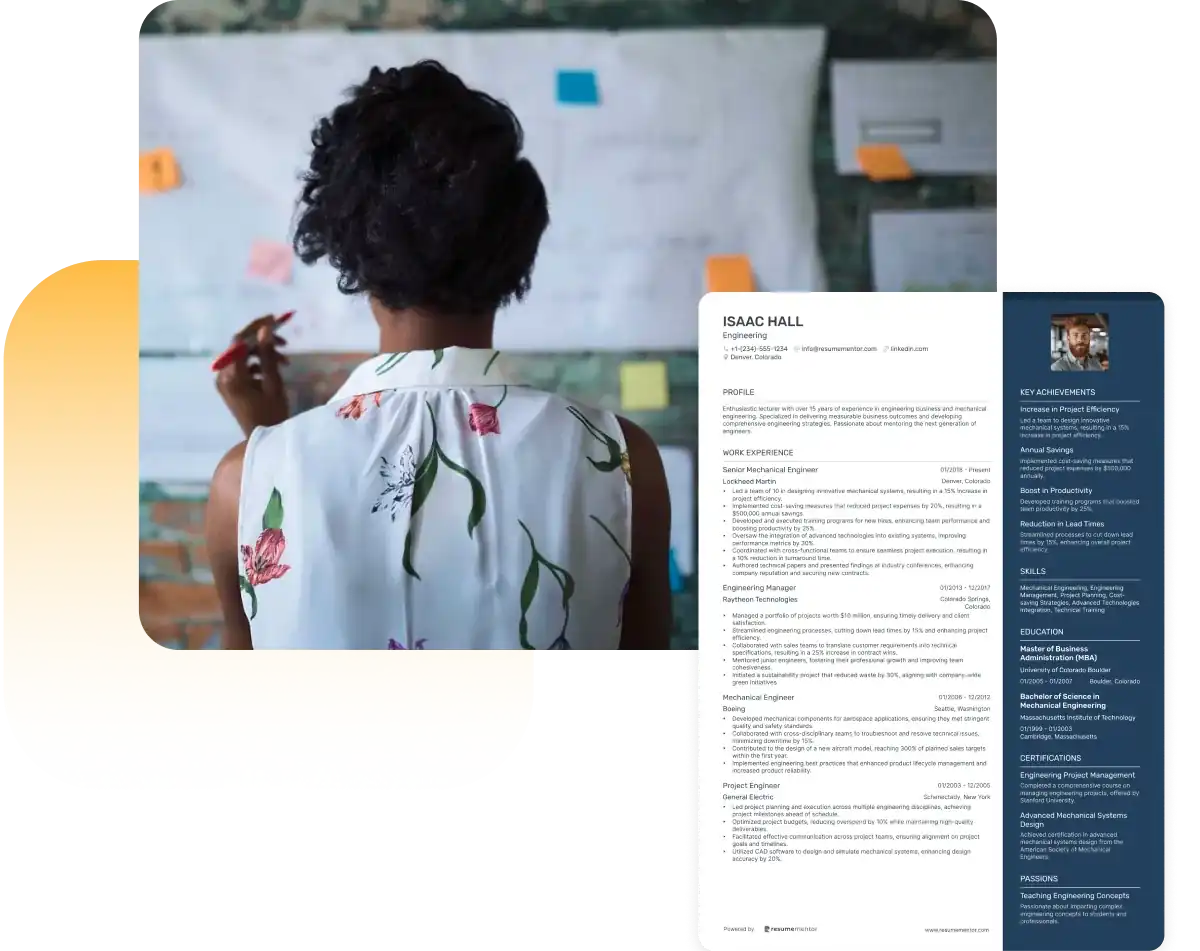
Continue Reading
Check more recommended readings to get the job of your dreams.
Resume
Resources
Tools
© 2025. All rights reserved.
Made with love by people who care.

